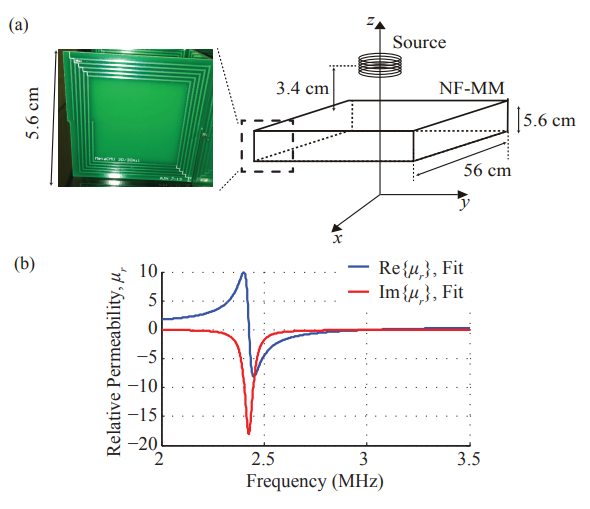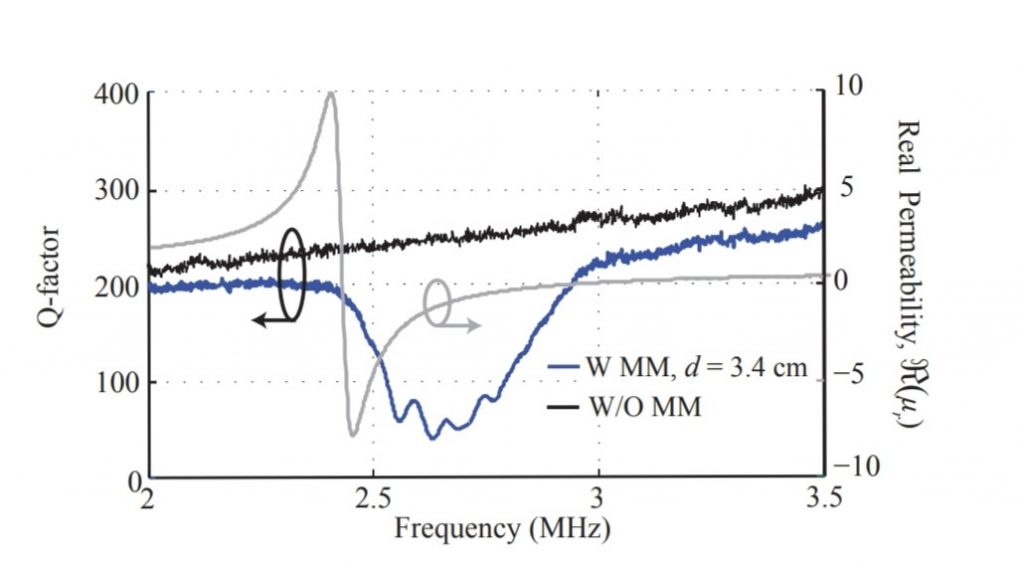Introduction
How near field metamaterials affect the quality factor of an excitation coil? Basically, in this article, first we take a look at how near field metamaterials (NF-MM) usually affect the quality factor (Q) of an excitation (i.e. source) coil. Thus, we demonstrate that when the permeability generally becomes negative, as a result magneto-static resonances (MR) occur, which are strongly coupled to the excitation coil and thus enhances the coil’s loss. Our simulation and experimental results reveals that the MR induced loss in an excitation coil can minimize Q by a factor of 4 or more.
Metamaterials are engineered materials which are enhanced to exhibit a property that they do not have in pure form. They are made from composite materials like plastics and metals. Metamaterials derive their properties from their new structure. Their new structure gives them ability to manipulate electromagnetic waves by absorbing and bending waves. Metamaterials have shown a lot of significance in near- field application where they provide enhanced permeability for both +ve and -ve regimes. Permeability is the ability of a material to allow magnetic field lines to pass through it. There are many types of meta materials. Some of them are as follows.
- Negative refractive index
- Hyperbolic
- Bandgap
- Double positive medium
- Bi-isotropic and Bi-anisotropic
- Chiral
There are many applications of metamaterials. But in this research, we will focus on near field metamaterials (NFMM). Most popular breakthrough in near field metamaterials and their applications is the enhancement of linkage between two coils. This was achieved by using the evanescent field produced by absorption or emission of electromagnetic waves by static elements. This phenomenon occurs when the permeability of metamaterials is negative. Evanescent fields are electric/magnetic fields which does not spread as electromagnetic waves, but their energy is strong at the core.
The main reason for the success of metamaterials is their effect on source coil. In near field applications, effect on inductance and quality factor are most important. In this paper, we will find out the effect of NFMM on quality factor and the effective loss induced in source coil due to NFMM. It is very different from linking two coils with each other. In this work, we will record the effects of NFMM on a single coil.
Methodology and Block diagram:
we will make a near field metamaterial by connecting a collection of small elemental cells which also consists of an inductor and capacitor of resonant frequency ωo. inductor combined with a discrete capacitor on a PCB circuit is often called spiral inductor. The construction of our NFMM is Anisotropic. The quality factor can be measured from this element. The calculation of quality factor can be done using the expression given below.

In above expression, F is the filling factor of cell, ω is the resonant frequency of individual element and ωo is the resonant frequency. The setup of circuit and permeability-frequency graph is shown in the figure given below.

How near field metamaterials affect the quality factor of an excitation coil? The above figure shows that permeability of metamaterial increases with the increase in frequency. This phenomenon happens until the frequency of element is less then resonant frequency (ω<ωo). permeability of element becomes negative when frequency of element crosses resonant frequency. Eventually it will become positive with the increase in ω. In the region where permeability is negative, the element supports magnetostatics resonance.
To get the effects of metamaterials on quality factors, we perform a simulation. We take a test coil and place it at three different distances i.e. 2.4cm, 3.4cm, 4.4 cm. we chose a cylindrical element. We perform the simulation in 2D because it is faster and captures all the effects. We perform the simulation on all three cases. The diagram of simulation is shown in figure given below.

The second figure shows the quality factor of our element in all cases of simulation. In this, 2.6Mhz is the resonant frequency. Z component of our graph is unity. We use anisotropic material because it is easier to construct and have better result for wireless power transfer applications. Graph shows that before reaching resonant frequency, the quality factor is nominal. As it reaches resonant frequency, quality factor decreases and reaches its minimum value of 3 Mhz.
The third figure shows the magnetic field of NFMM near the source coil. This increased loss is explained by the strong resonant wave patterns. These patterns are magneto static resonant (MR). These resonant are paired with source coil. They transfer energy from source coils to dissipative elements of metamaterials. This shows the sudden decrease in quality factor. This means that metamaterials provide a benefit of enhancing of coupling multiple coils at a price of decreased quality factor. The benefit is too small and the loss is much larger.
Result and Conclusion:
How near field metamaterials affect the quality factor of an excitation coil? We have shown that the strong coupling of MR in the NF-MM when µ < 1 significantly decreases the quality factor of excitation or source coil. The significant reduction in Q will be an important design constraint in NF-MM application. Resultantly, by the reason of many factors the quality factor of the coil substantially minimizes. Hence, the major reduction which is caused in Q can considerably reduce the performance enhancements which are taken with the use of MM in the near-field applications. In contrast, the production of the coupling and creation of the surface waves offers to some other coils which can be receivers some more enhanced coupling in the certain surrounding area. But all this offering advantage is actually at the cost of a great higher loss. are also effectively coupled with it.
In order of correlation of our respective stimulated finding with the experiment, we thus make a MM which can be shown in the figure 1[4] also the permeability which was obtained by applying the method in the [4] can be shown in the figure 1(b).
Thus, we placed a coil at a distance of about 3.4cm from usually the one surface of the NF-MM.
Then, over the frequency we calculated the Q which is generally at positive and then negative μ. Thus, the figure 3 demonstrates the Q irrespective of NF-MM means it has no dependence over it. Similarly, plotted is usually the real part of the certain permeability in order to correlate the basic change in Q to the magnitude and the basic sign of the permeability. However, in the area of negative μ, we thus can see a ≈ 4X decline in the Q, which basically resembles so with the stimulated outcome.

Future Work:
Metamaterials have great significance in future as we can degrade the quality factor Q and find numerous near field applications. Moreover if we apply better techniques for +ve and -ve permeability regimes in future, this can be a very beneficial project/ research in near future.
Also read here
https://eevibes.com/electromagnetic-field-theory/what-is-milikans-oil-droplet-method/